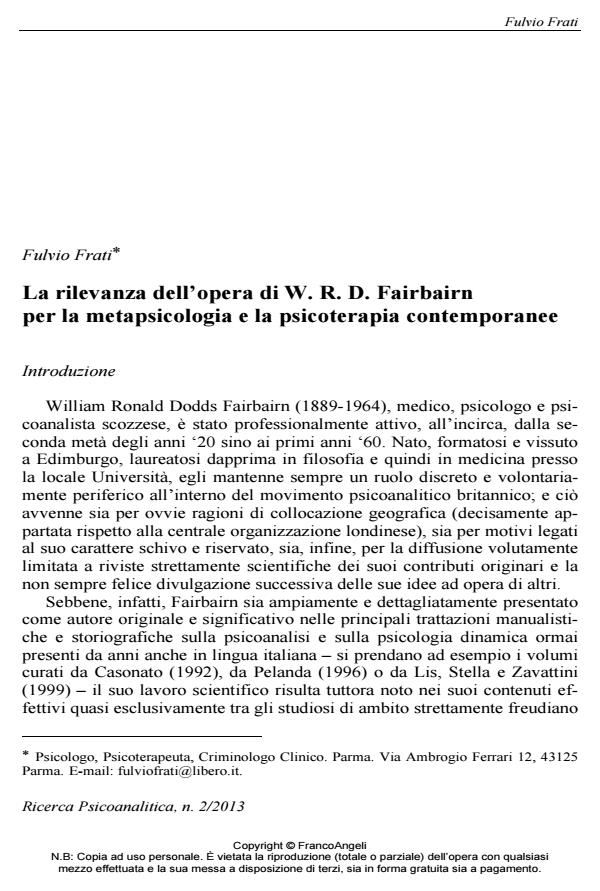La rilevanza dell’opera di W. R. D. Fairbairn per la metapsicologia e la psicoterapia contemporanee
Titolo Rivista RICERCA PSICOANALITICA
Autori/Curatori Fulvio Frati
Anno di pubblicazione 2013 Fascicolo 2013/2
Lingua Italiano Numero pagine 21 P. 105-125 Dimensione file 231 KB
DOI 10.3280/RPR2013-002007
Il DOI è il codice a barre della proprietà intellettuale: per saperne di più
clicca qui
Qui sotto puoi vedere in anteprima la prima pagina di questo articolo.
Se questo articolo ti interessa, lo puoi acquistare (e scaricare in formato pdf) seguendo le facili indicazioni per acquistare il download credit. Acquista Download Credits per scaricare questo Articolo in formato PDF

FrancoAngeli è membro della Publishers International Linking Association, Inc (PILA)associazione indipendente e non profit per facilitare (attraverso i servizi tecnologici implementati da CrossRef.org) l’accesso degli studiosi ai contenuti digitali nelle pubblicazioni professionali e scientifiche
Lo psicoanalista scozzese W.R.D. Fairbairn (1889-1964) appare, a chiunque si accosti oggi alla sua opera, come un significativo precursore di alcune tra le principali tendenze teoriche e cliniche della psicoanalisi e della psicoterapia più recenti. In questo articolo, l’autore cerca innanzitutto di evidenziare il complessivo modello metapsicologico del funzionamento della mente messo a punto da questo studioso, per illustrare in particolar modo i principali contributi teorici che caratterizzano l’originale teoria delle relazioni oggettuali a lui attribuibile. Vengono infine proposte alcune riflessioni sul cambio di paradigma scientifico avvenuto nei primi trent’anni del XX secolo col passaggio dalla fisica atomistica a quella quantistica, a cui Fairbairn si è esplicitamente riferito nella propria teorizzazione e che riveste ancor oggi, anche relativamente agli ambiti della psicologia generale, della psicopatologia e della psicoterapia, una particolare attualità.
Parole chiave:Fairbairn, metapsicologia, oggetto, psicoterapia, relazione
- Dalla ‘mente isolata’ al ‘volo degli storni’ Fulvio Frati, in Ricerca Psicoanalitica /2022
DOI: 10.4081/rp.2022.648 - Il conflitto intrapsichico e l'evoluzione storica del suo approccio psicoterapeutico in psicoanalisi Fulvio Frati, in Ricerca Psicoanalitica /2021
DOI: 10.4081/rp.2021.535
Fulvio Frati, La rilevanza dell’opera di W. R. D. Fairbairn per la metapsicologia e la psicoterapia contemporanee in "RICERCA PSICOANALITICA" 2/2013, pp 105-125, DOI: 10.3280/RPR2013-002007